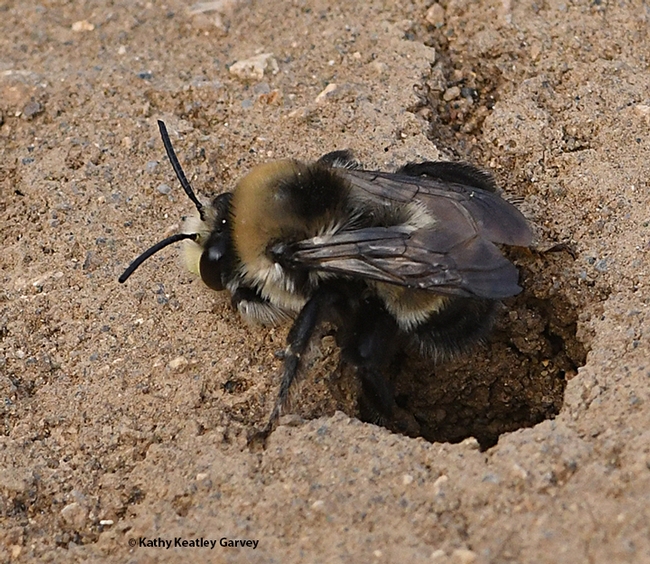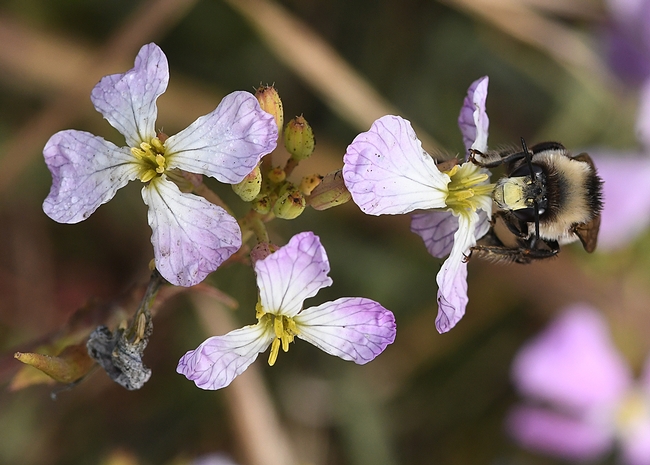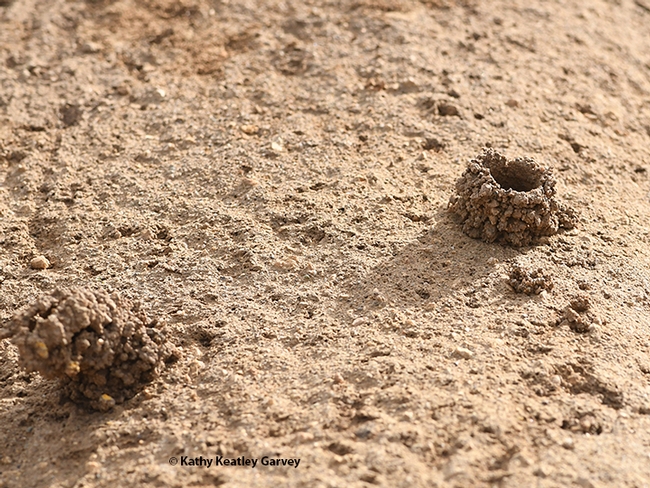- Author: Kathy Keatley Garvey
Who takes images of yellowjackets?
What, nobody?
I don't usually photograph yellowjackets because (1) I prefer to take images of their cousins, the honey bees and (2) yellowjackets are always moving. By the time I observe one, and raise the camera, the insect is long gone.
You've probably seen yellowjackets hosting their "huge family reunions" at your picnic table. These uninvited guests help themselves to your food, especially such protein as hamburgers and hot dogs--and sugary substances like cake and soft drinks. Avoid the 'jackets. They can be very aggressive.
However, a trip on Aug. 31 to Doran Regional Park Beach, Bodega Bay, proved to be "Yellowjacket Portrait Day" or "Getting Social with a Social Wasp." It all began around dawn when I noticed movement in a blooming Myoporum (a genus of flowering plants in the figwort family, Scrophulariaceae).
Then I spotted a western yellowjacket, Vespula pensylvanica, staring at me. Take my picture! C'mon! I'm a social wasp. Don't you think I deserve a picture, what with all you humans forever targeting me?
Okay, stay still. Don't return to your nest right now. And if you do, don't bring back your nestmates."
"Yellowjackets are social wasps that build large, hidden nests," writes Lynn Kimsey, director of the Bohart Museum of Entomology and a UC Davis distinguished professor of entomology, on an online fact sheet. "The nests are usually subterranean in rodent burrows or in cavities in trees, walls or attics. "
"Yellowjacket nests can be huge with 50,000 to 100,000 workers," Kimsey points out. "In temperate climates these colonies are annual. Their nests die in the fall after producing new queens. New queens produced by the colonies in the fall spend the winter in protected places until spring when they found new colonies. Yellow jacket colonies can become perennial in warmer climates, such as in Hawaii and coastal California. In these situations the nests can become enormous, with millions of workers!"
Says the UC Statewide Integrated Pest Management (UC IPM) Program in its Pest Note on "Yellowjackets and Other Social Wasps": "In California, yellowjackets are the primary pests among the social wasps. In Western states there are two distinct types of social wasps—yellowjackets and paper wasps. Yellowjackets are by far the most troublesome group, especially ground- and cavity-nesting ones such as the western yellowjacket, which tend to defend their nests vigorously when disturbed. Defensive behavior increases as the season progresses and colony populations become larger while food becomes scarcer. In fall, foraging yellowjackets are primarily scavengers, and they start to show up at picnics and barbecues, around garbage cans, at dishes of dog or cat food placed outside, and where ripe or overripe fruit are accessible. At certain times and places, the number of scavenger wasps can be quite large."
UC IPM goes on to note that "Concern about yellowjackets is based on their persistent, pugnacious behavior around food sources and their aggressive defense of their colony. Usually stinging behavior is encountered at nesting sites, but sometimes scavenging yellowjackets will sting if someone tries to swat them away from a potential food source. When scavenging at picnics or other outdoor meals, wasps will crawl into soda cans and can sting your lips or the inside of your mouth or throat."
However, "Most social wasps provide an extremely beneficial service by eliminating large numbers of other pest insects through predation and should be protected and encouraged to nest in areas of little human or animal activity," UC IPM relates. "Although many animals prey on social wasps—including birds, reptiles, amphibians, skunks, bears, raccoons, spiders, praying mantids, and bald-faced hornets—none provides satisfactory biological control in home situations." (Read more on the UC IPM site)
So what happened to the solo yellowjacket at Bodega Bay? It hung around for several minutes and then took flight.
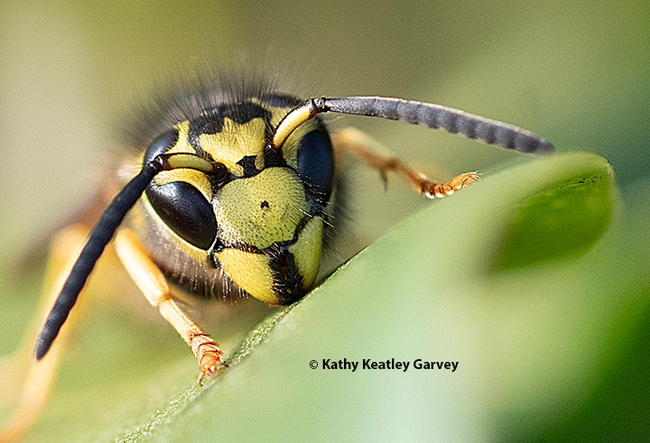
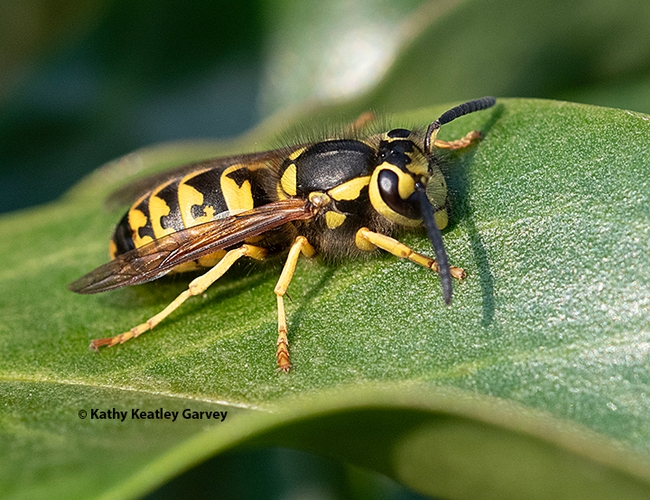
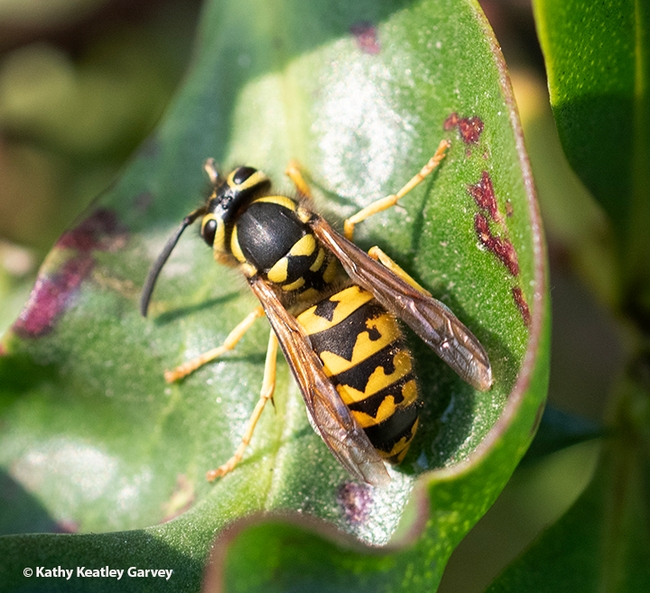
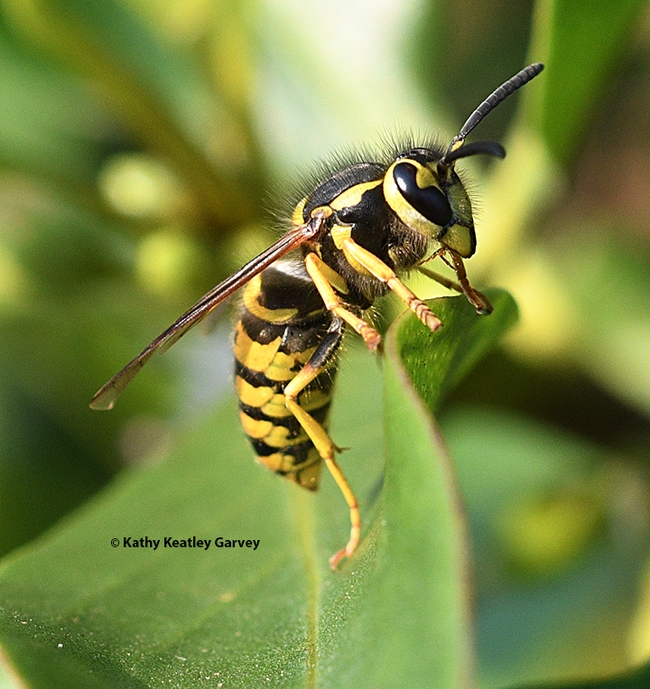
- Author: Kathy Keatley Garvey
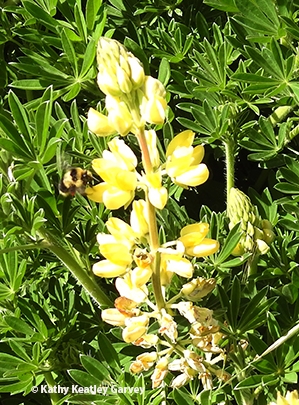
Windy? 27 mph!
We didn't think we'd see a single bumble bee foraging on the blooming ice plants, poppies, wild radishes, or lupines, but there it was, a black-tailed bumble bee, Bombus melanopygus, nectaring on a yellow lupine near the entrance to Doran Regional Park.
This bumble bee species is one of the earliest to emerge in the spring. We've seen it as early as Jan. 1 in Benicia. And the Bohart Museum of Entomology, UC Davis, coordinates a contest to see who can find and photograph the first bumble bee of the year in the two-county area of Yolo and Solano. This year Ria de Grassi of Davis spotted a B. melanopygus, foraging on her ceanothus plant in her backyard on Jan. 8. (See Bug Squad blog.)
But back to the Bombus at Bodega. How can a tiny bumble bee, ranging from 0.6 to 1 inch in length, withstand that 27 mph wind, which seemed near gale force? Bumble bees pay no attention to gale force, which the National Weather Service defines as between 34 and 47 knots (39 to 54 mph).
Bumble bee authority John Ascher messaged me: "Their flight and resistance to cold is amazing!" Truly!
"Powerful flight muscles are packed into their stout little bodies, which are covered in thick fur," according to an Aug. 2, 2021 post in Imprint Ecology, Chichester, West Sussex, England. "These can propel them through high winds, in comparison to honeybees and butterflies who find it difficult to get airborne in wind above 20 mph. In addition, bumblebees can dislocate their flight muscles and shiver them to keep warm which is very useful on wet, windy days. Even in winter, you can see big queen bumblebees happily foraging on gorse, heather and crocus, when no other insects are out and temperatures have barely reached double figures."
"Bumblebees evolved in the Himalayas, around 25 to 40 million years ago. They are designed to withstand bleak, windy, mountainous climates and don't actually fare very well in hot places."
The black-tailed bumble bee predominantly has pale yellow hair "with bands of black hair between the wing bases and across the middle of the abdomen," according to the quartet of UC-based scientists, Gordon Frankie, (the late) Robbin Thorp, Rollin Coville and Barbara Ertter, in their book, California Bees and Blooms: A Guide for Gardeners and Naturalists.
They also forage quickly, especially in a strong wind...or an uninvited gust.
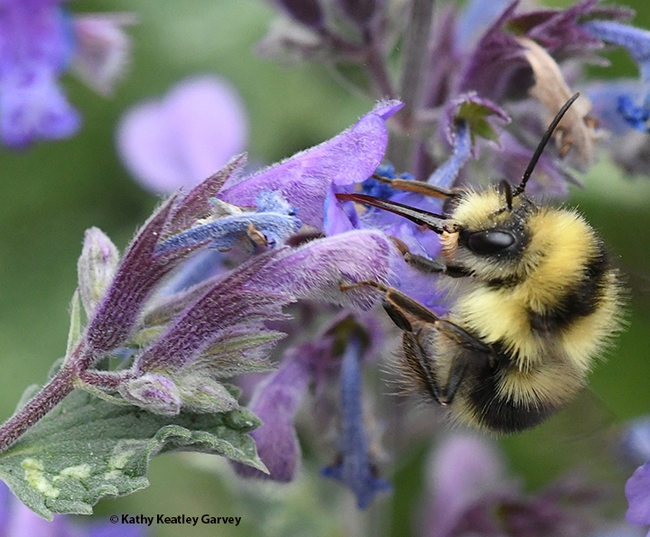
- Author: Kathy Keatley Garvey
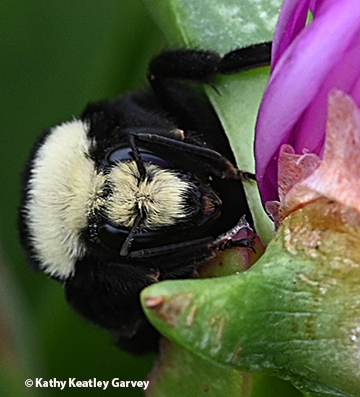
The yellow-faced bumble bee bursts from a neon pink blossom in the video below.
It's Oct. 19, 2022 and the temperature has soared to an unseasonal 81 degrees. This bumble bee is hungry. She may have emerged from hibernation "to get a bite to eat," as the late Robbin Thorp, UC Davis distinguished emeritus professor of entomology, used to say about late-in-the-season sightings.
B. vosenenskii, native to the west coast of North America, from Baja California to British Columbia, is an important pollinator, especially important for its buzz pollination of tomatoes, peppers and cranberries. In buzz pollination, the bumble bees grab a blossom and shake it, dislodging the pollen to accomplish pollination.
The ice plant, Carpobrotus edulis, is a native of South Africa and known as an invasive weed.
Interesting that on one end of the Doran Regional Park, volunteers with the California Native Plant Society are pulling out the ice plant to make room for native plants, while on the other end, a bumble bee hungrily sips the nectar. "Ice plant chokes out native plants and alters the local soil composition," according to the park website. "Removing ice plant allows native, endangered plants to repopulate the area and wildlife to thrive."
Want to learn more about the bumble bees around us? Read these two books, both co-authored by Thorp in his retirement: Bumble Bees of North America: An Identification Guide (Princeton University, 2014) and California Bees and Blooms: A Guide for Gardeners and Naturalists (Heyday, 2014).
And, if you see a bumble bee and would like to get involved in citizen science, Bumble Bee Watch seeks your sightings.
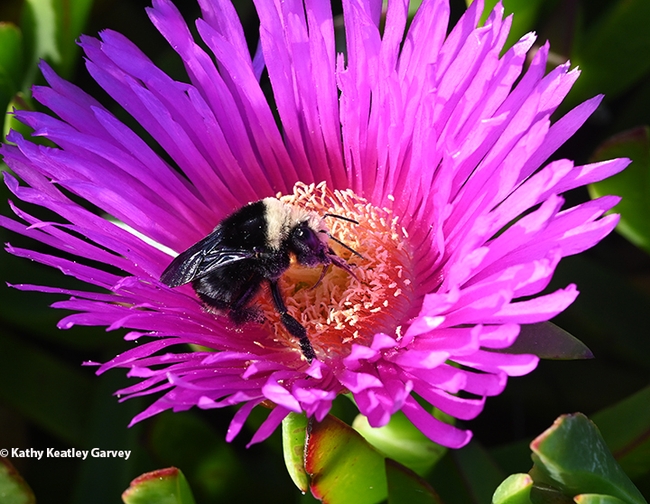
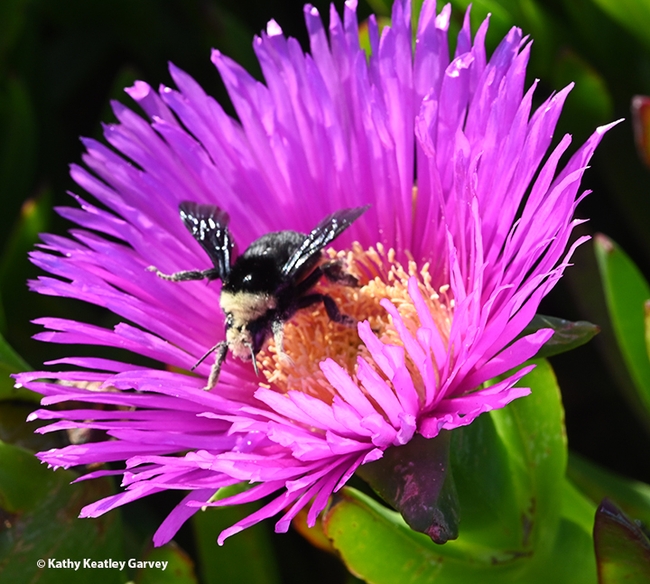
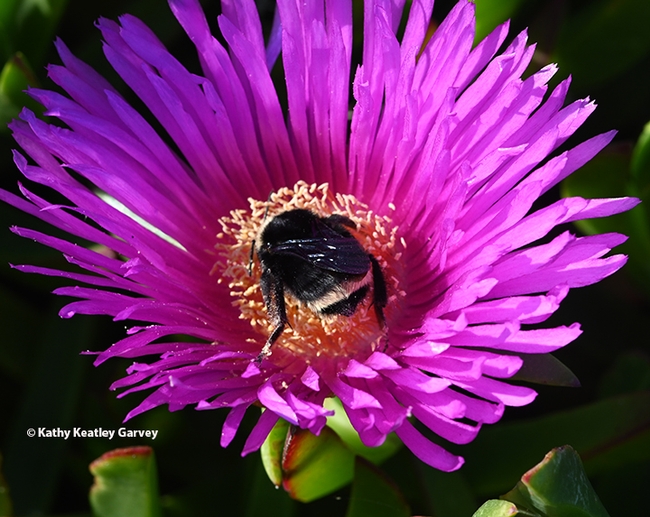
- Author: Kathy Keatley Garvey
What's better than seeing a yellow-faced bumble bee, Bombus vosnesenskii, foraging on an neon pink ice plant at Bodega Bay?
Seeing two bumble bees on the same flower.
That's what we observed on a recent trip to Doran Regional Park, Bodega Bay, Sonoma County. It was bumble bee heaven. While conservationists are removing ice plant in one area of the park, bumble bees are foraging on the flowers in another area.
B. vosnesenskii is a native. The ice plant, Carpobrotus edulis, is not. It's from South Africa. Conservationists are removing the invasive ice plant "to allow native, endangered plants to repopulate the area and wildlife to thrive."
But meanwhile, this Bombus keeps buzzing and foraging. (Bombus is derived from a Latin word meaning "buzzing.")
Bumble bees are important pollinators (think "buzz pollination" on tomatoes) but we haven't seen them much around Solano and Yolo counties this year.
Sonoma County, yes! Bodega Bay seems to be an oasis.
And speaking of bumble bees, the Bohart Museum of Entomology sponsors an annual Robbin Thorp Memorial First-Bumble-Bee-of-the-Year Contest to see who can find the first bumble bee of the year in the two-county area of Yolo and Solano.The first to photograph one and email to the Bohart Museum wins. This year UC Davis doctoral candidate Maureen Page of the Neal Williams lab, UC Davis Department of Entomology and Nematology, photographed B. melanopygus with her cell phone camera, and horticulturist Ellen Zagory, retired director of public horticulture for the UC Davis Arboretum and Public Garden, photographed B. vosnesenskii with her Sony camera.
Coincidentally, they each took their photos at exactly 2:30 p.m., Jan. 1 in the 100-acre UC Davis Arboretum and Public Garden as the bees foraged on manzanita.
They represented "a double," too--a double win.
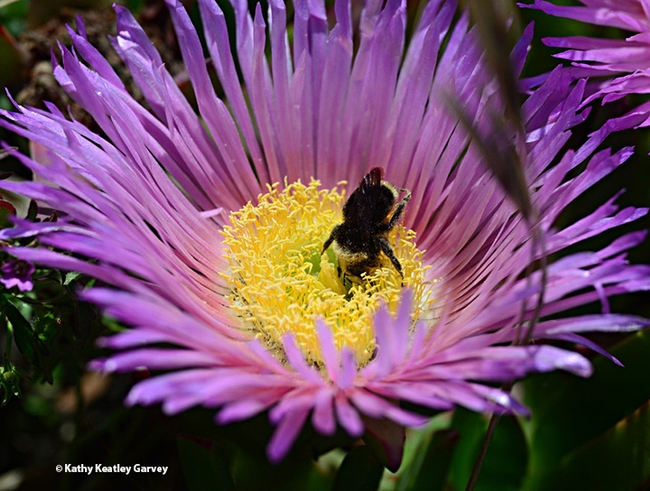
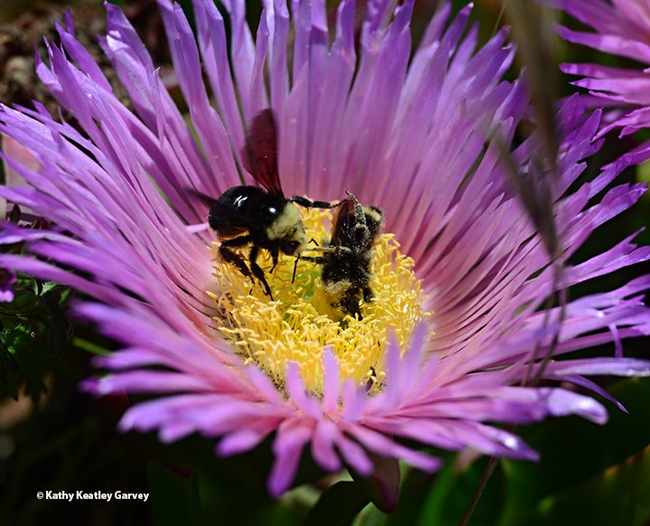
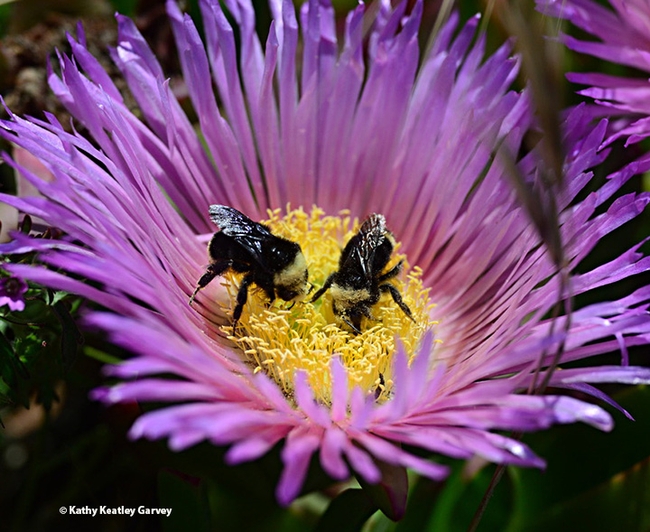
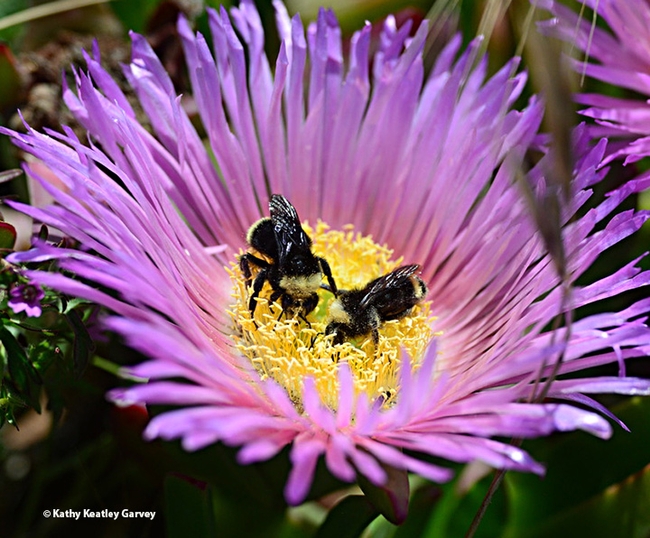
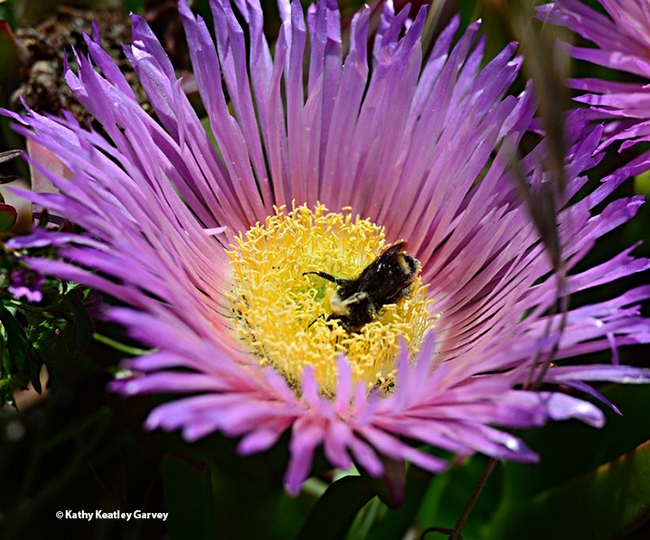
- Author: Kathy Keatley Garvey
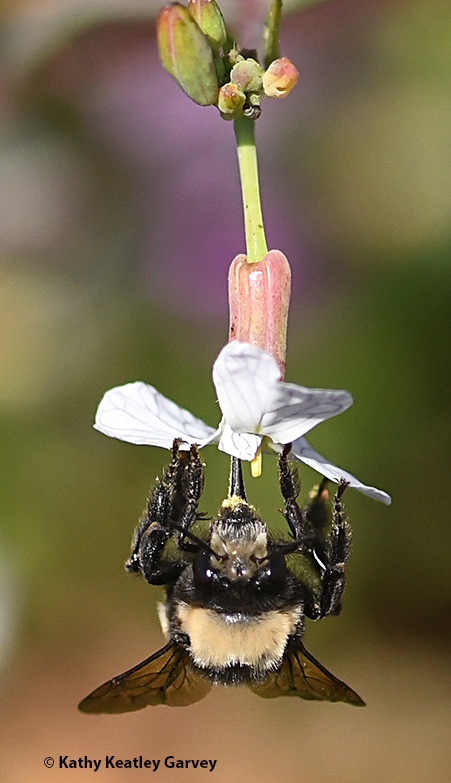
But have you ever seen the digger bees?
They're out there.
The sand cliffs are the home of the digger bee, a bumble bee mimic known as Anthophora bomboides stanfordiana. This bee builds turrets in the sand cliffs.
Last Thursday we watched several digger bees warm their flight muscles, take flight, and forage on the lupine, wild radish, and seaside daisy. Then we saw the females zipping in and out of their turrets: their cozy castles in the sand.
As the late Robbin Thorp, a global authority on bumble bees and a UC Davis distinguished emeritus professor of entomology, told us several years ago: "The species name indicates that it is a bumble bee mimic. These bees need a source of fresh water nearby. Females suck up water, regurgitate it on the sandstone bank surface, then dig away at the soft mud. They use some of the mud to build entrance turrets, presumably to help them locate their nests within the aggregation of nests."
"The female," Thorp said, "sucks up fresh water from nearby, stores it in her crop (like honey bees store nectar) for transport to the nest. She regurgitates it on the sandstone, and excavates the moistened soil. She carries out the mud and makes the entrance turret with it."
As part of a National Science Foundation grant, community ecologist Rachel Vannette, assistant professor, UC Davis Department of Entomology and Nematology, is teaming with other colleagues, including pollination ecologist Stephen Buchmann, to research these digger bees and their nests.
It's a big beautiful bee world out there.
